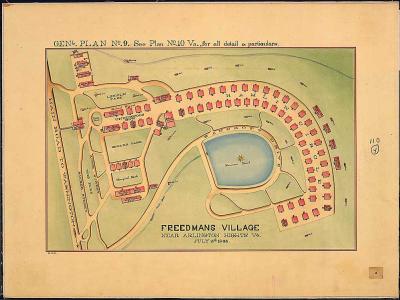
National Archives and Arlington National Cemetery host discussion on Freedman’s Village
By Pete Lewis | National Archives News
WASHINGTON, February 29, 2024 – On February 28, the National Archives and Arlington National Cemetery welcomed a panel of historians and archivists to discuss Freedman’s Village, a community of formerly enslaved African Americans established in 1863 in Arlington, VA.
Participating panelists included Damani Davis, an archivist from the National Archives; Allison Finkelstein, Arlington National Cemetery’s senior historian; and Steve Hammond, a genealogist, family historian, and seventh-generation member of the Syphax family of Washington, DC. Amber Forrester, an archivist from the National Archives, served as moderator.
Archivist of the United States Dr. Coleen Shogan opened the ceremony with a brief history of Freedman’s Village.
“Many formerly enslaved African Americans traveled North seeking refuge during the Civil War. Thousands made their way here, to Washington, DC, looking for help in the nation’s capital. In response, the federal government established the Freedman’s Village in Arlington, Virginia, on the estate previously owned by the family of Confederate general Robert E. Lee,” Shogan stated. “This planned community, located in the heart of what would eventually become Arlington National Cemetery, provided shelter and opportunities for work, job training, and education.”
The village evolved into a unique and thriving community with schools, hospitals, churches, and social services. While intended to be temporary, the community remained on the land from 1863 until 1900, and it had a lasting legacy.
Following Shogan’s words, the panelists presented a webinar, tracing the origins, evolution, and eventual demise of the remarkable community of formerly enslaved people who built new lives for themselves. Freedman’s Village would be a place where tens of thousands of newly free African Americans would experience a most profound change in their lives, including Sojourner Truth, who would go on to become a historic abolitionist and affect meaningful reform.
“This was more than a refugee camp,” Hammond expressed. “The village was a hopeful symbol of a better future for people who had spent their lives in bondage. It represented the larger, overwhelming project of transitioning from enslavement to freedom—a process that would continue for decades, and the repercussions of which continue to impact our nation today.”
A question-and-answer session with the audience was held following the webinar.
For more information on Freedman’s Village, visit the National Archives Catalog and the Arlington National Cemetery website.
View the event on the National Archives YouTube channel.
